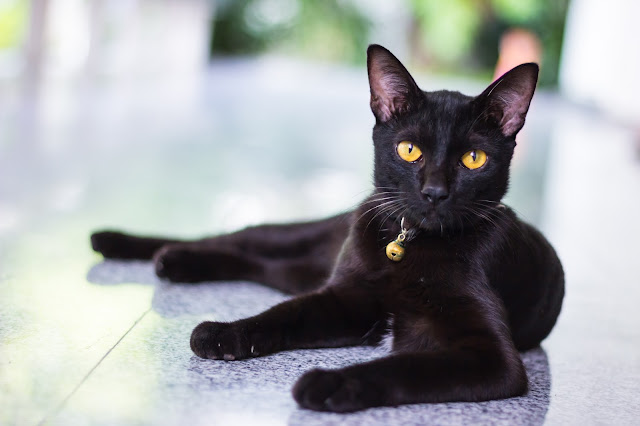 |
| Bengal cat. Photo by Svetlana Valiskaya. |
In our continuing exploration into the
leopard cat and its
possible domestication in ancient China, today we consider the Bengal cat, a domestic
breed that is a cross between the wild leopard cat and a domestic cat. These
crosses were being made by the late 19th century, if not earlier, though the
breed didn’t become “official” until a century later.
The modern Bengals offered by reputable breeders are at
least four generations removed from their wild ancestors but still have that
wildcat look, with handsome and vividly colored spotted or marbled coats. Bengals
are in the medium to large size range for domestic cats and are known for their
active, inquisitive nature. Just like their leopard cat relatives, these cats enjoy
water and sometimes jump into the bath or shower. They also enjoy high places.
While, yes, they are domesticated, a Bengal will always be
its own cat. They’ve been described as “rambunctious, funny, beautiful and
dynamic” (TICA) and “happiest when [they are] the center of attention
(Pickeral, 212).
Our favorite thing about Bengals, though, is that they have
a rich and interesting history.
Early history
We can’t say for sure when the first cross between a leopard
cat and a domestic cat happened. The first record of such a hybrid (at least
that we could find) appeared in 1889, when the noted British cat fancier Harrison
Weir wrote of a cat he’d seen at the Zoological Society Gardens in Regent’s
Park. It was said to be the offspring of a male “wild cat of Bengal and a tabby
she-cat.” The cat, Weir said, was “handsome, but very wild.”
The next known record is from 1934, when a leopard cat–domestic
hybrid was mentioned in a Belgian scientific journal. Unfortunately, although
lots of people know (or have repeated) that this unnamed Belgian scientific journal
mentioned this hybrid cat, no one seems to know what said journal actually had
to report about said cat.
Breeding begins
We next pick up the Bengal’s story in 1961, when Jean Sugden
Mill, an American interested in cat breeding, obtained a wild leopard cat. This
cat “got involved” with Mill’s black domestic cat, and the result was one
kitten. Some sources give the date of this breeding as 1963 (TICA). This
nascent breeding project petered out, but Mill would reappear a little later in
the breed’s history.
The leukemia connection
 |
Leopard cat-domestic cat hybrids intrigued cancer
researchers in the 1970s. Domestic cats carry the
genome for a feline leukemia virus in their DNA,
but leopard cats do not. What would happen to
the virus genome in the hybrid cats?
Illustration © Saporob | Dreamstime.com Dna |
Leopard cat–domestic hybrids also played a role in leukemia
research. Domestic cats carry the genome for the Type C feline leukemia virus
in their DNA and pass it on to their offspring; wild leopard cats do not. In
the 1970s, a Loma Linda University geneticist named Willard R. Centerwall
wondered what would happen to the leukemia genome in hybrids of the two
species. He hoped that investigations into that question would help scientists
better understand leukemia in humans.
In conjunction with Dr. Raoul Benveniste of the National
Cancer Institute in Maryland, Centerwall began a breeding program to produce
leopard cat–domestic hybrids and then “backcross” the female hybrids with male leopard
cats and domestic cats. (Males in the first generation of hybrids were all
sterile, so the hybrids could not be bred to one another.)
There was a problem, though: The half-wild mothers tended to
kill their kittens. The solution? Adopt the kittens out to Loma Linda students
and employees to be placed with domestic mother cats and their litters. After
they were weaned, the hybrids would then be returned to Dr. Centerwall.
Most of these cats were housed at Loma Linda University
Medical Center, though some were kept at private homes. Dr. Centerwall
described the hybrid offspring as “edgy.” Some could become tame with frequent
handling after weaning, but they were “almost impossible to housebreak” (Gleaner). In other words, not great
pets.
The breed gets a name
 |
Bengals are known for
being active and playful.
Photo by Eric Isselée. |
So far in this history, we haven’t referred to the hybrid
cats as “Bengals.” That’s because they didn’t get that name until 1970, when another
American, Bill Engler, bred a male leopard cat to two domestic females and
called the kittens Bengals. Five years later, Engler had more than 60 Bengals,
and the cats were into the third generation.
This is the point where Jean Sugden Mill comes back into the
picture. In 1980 she was given some first-generation kittens from Dr.
Centerwall, then she received some more hybrids from another cat person (these had
also originated from Centerwall) and she started breeding again. In efforts to
increase the gene pool, Mill added other cats to her breeding program,
including an Indian street cat credited with giving some Bengals a glittery
coat. Mill’s efforts resulted in the “ideal” Bengal, a cat named Millwood Penny
Ante who became well known on the cat show circuit.
Today the breed is accepted by many (though not all) cat
fancy associations, including the American Cat Fanciers Association and The
International Cat Association.
Most importantly, Bengals continue to be fascinating.
Sources
Gleaner. (1977,
October 3). “Leukemia’s Hereditary Factors Are Studied,” p. 17.
Pickeral, Tamsin. (2013). “Bengal,” in The Elegance of the Cat: An Illustrated History, pp. 212–219.
Hauppage, NY: Barron’s.
Weir, Harrison. (1892). Our
Cats and All About Them. Kindle edition created from the new edition of
1892.




























